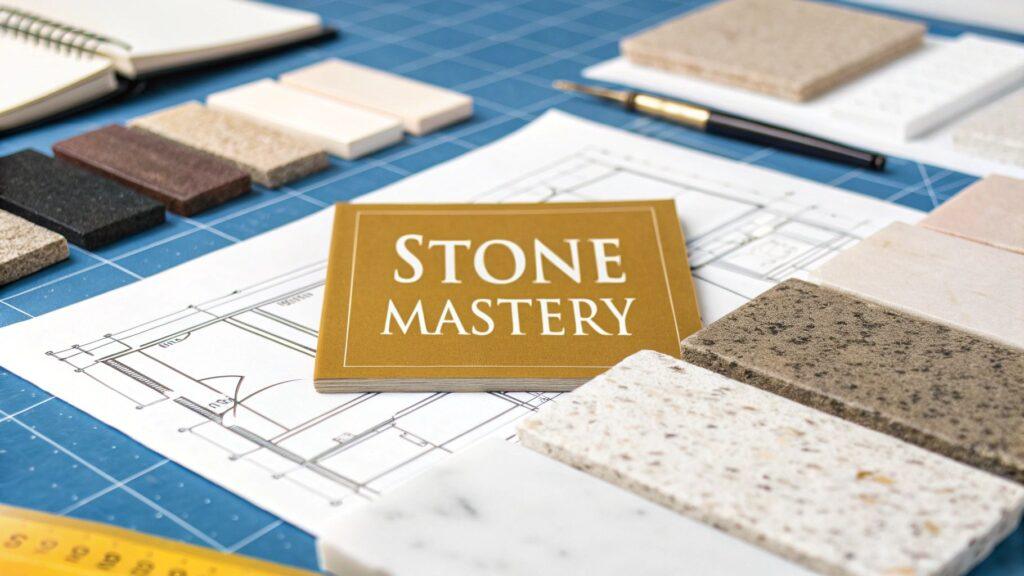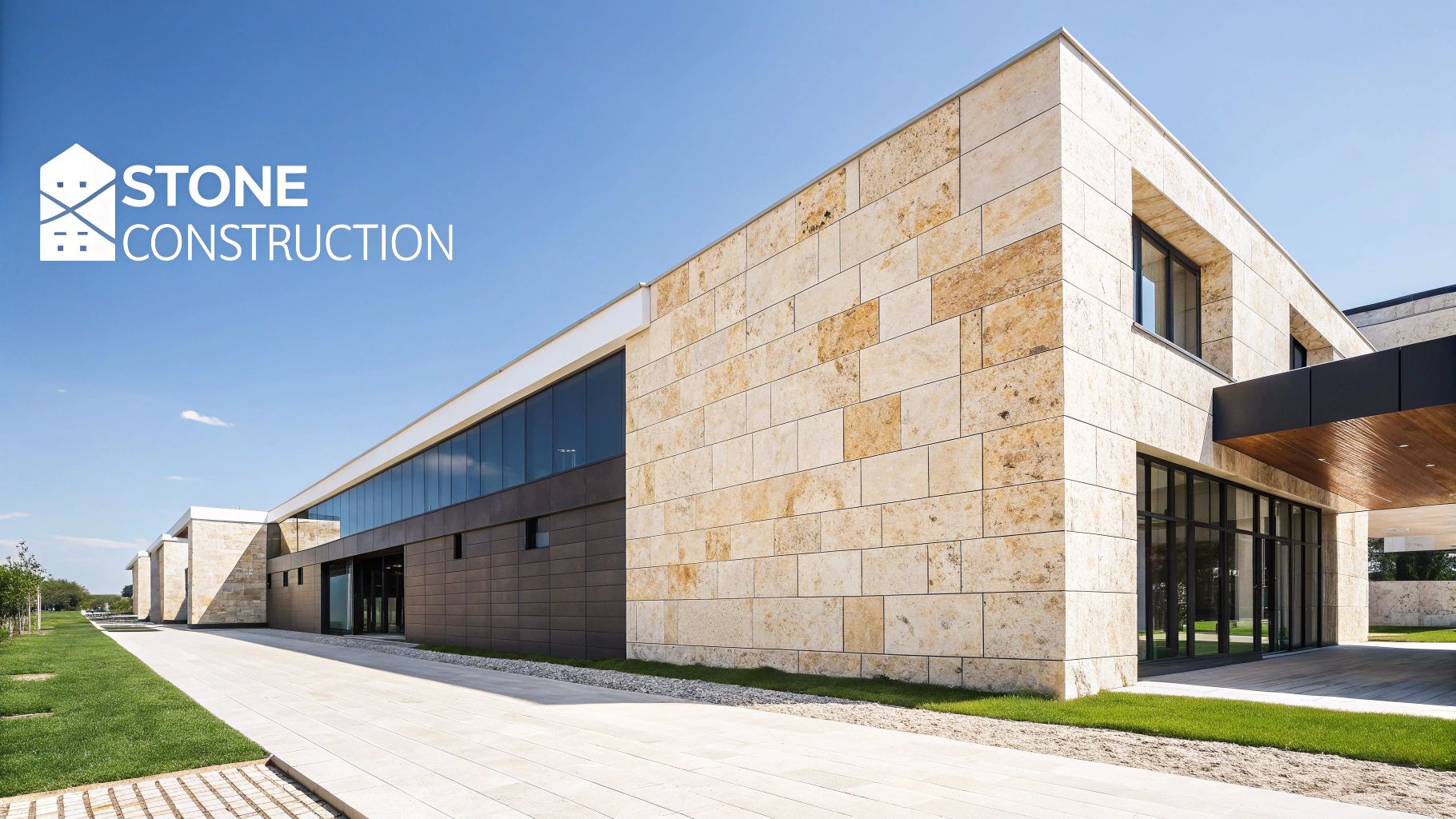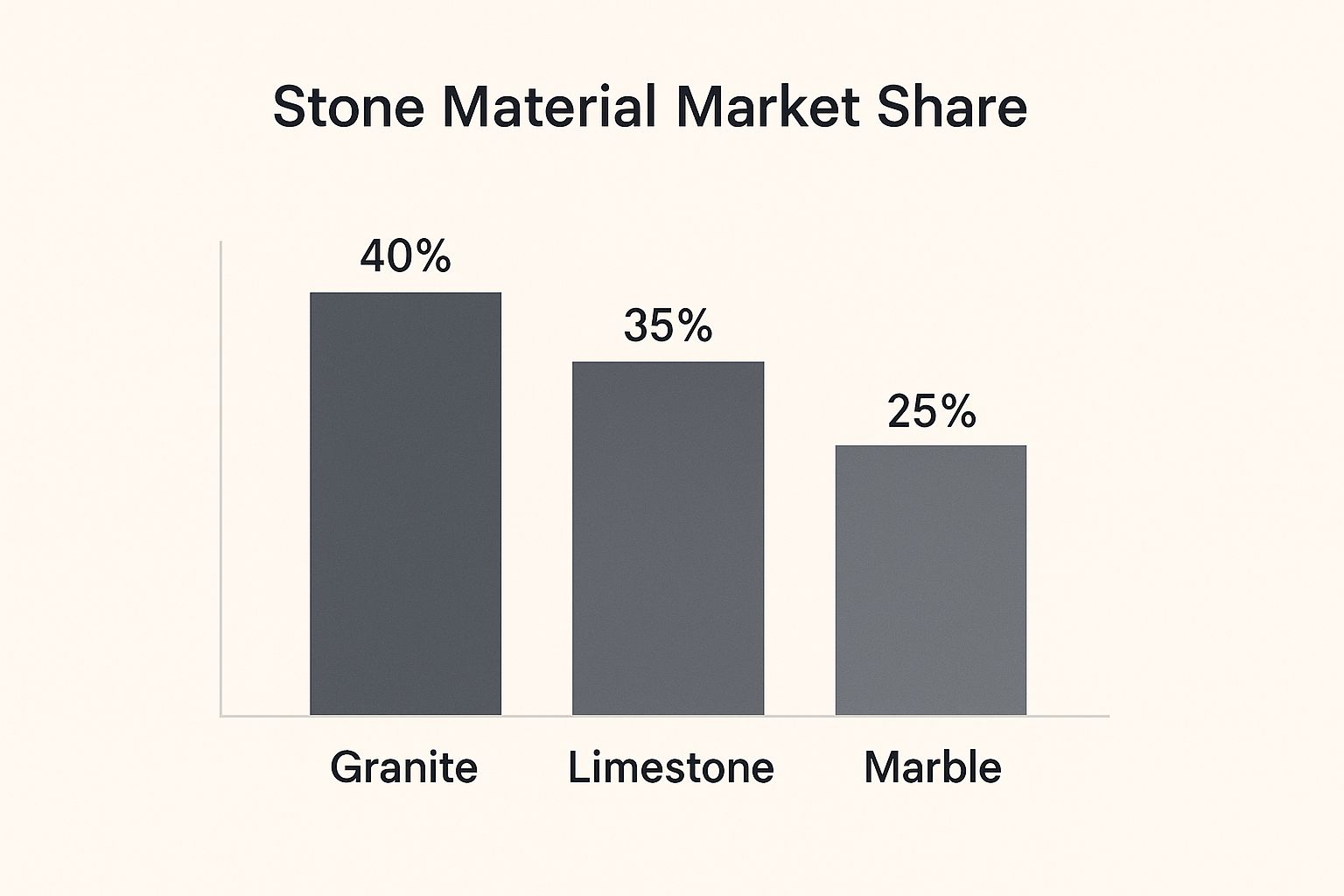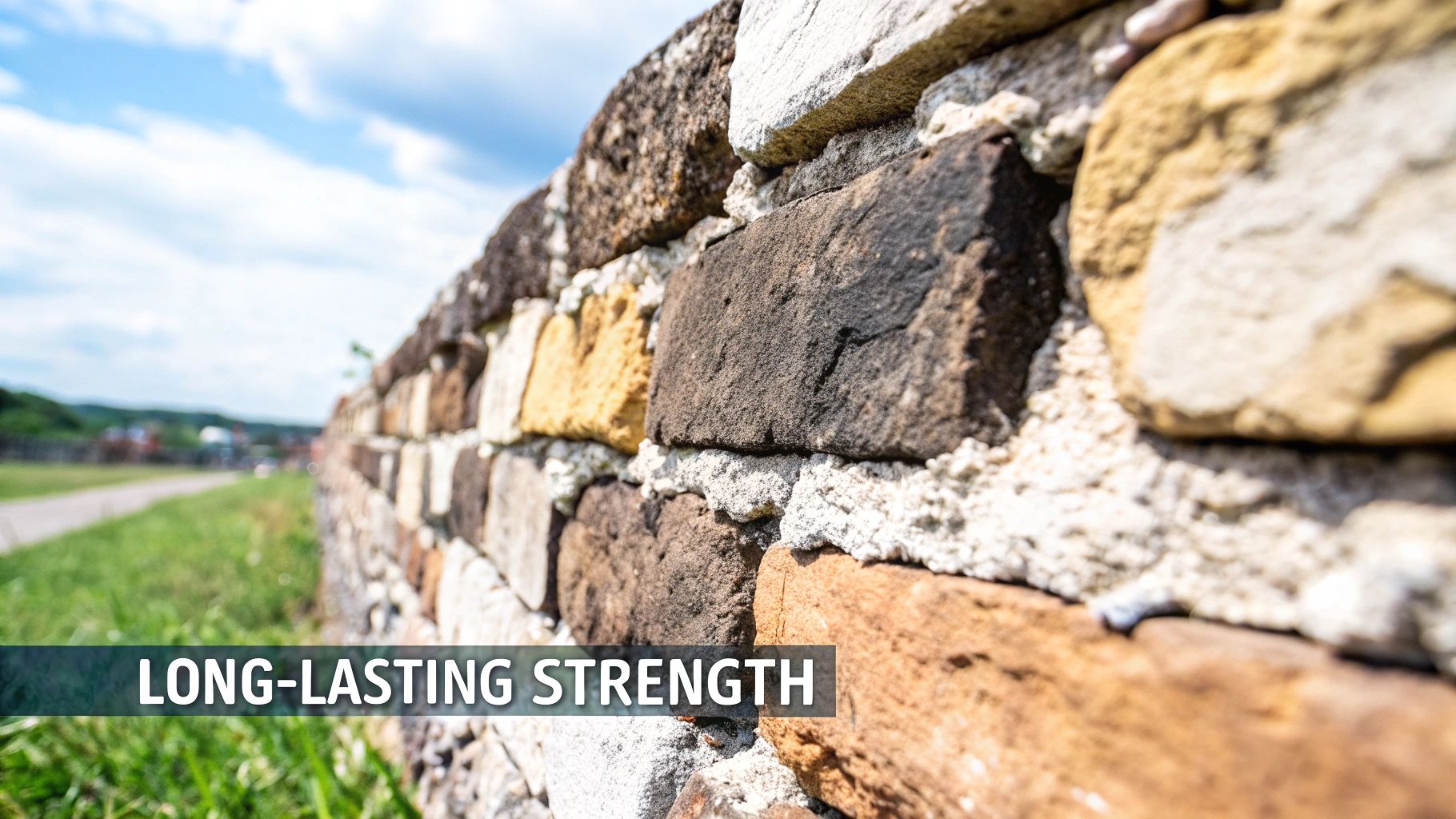Understanding Stone Construction Material Fundamentals
Imagine walking through an award-winning architectural firm. You'll likely notice stunning visuals, innovative designs, and a palpable sense of craftsmanship. But underlying all of that is a deep understanding of materials, particularly stone. Choosing the right stone isn't just about picking something that looks good; it's about understanding the story the stone tells, a story written over millions of years.
This story begins with the stone's geological history. How was it formed? What pressures did it endure deep within the earth? These processes are what give each type of stone its unique properties. They are the foundation of a material's strength, its ability to absorb water, and even its visual appeal.
Let's take granite, for example. This igneous rock is born from molten magma cooling slowly beneath the Earth's surface. That slow cooling allows large crystals to form, interlocking like pieces of a puzzle, which is why granite is so strong and durable. It's a perfect choice for high-traffic areas like kitchen countertops or flooring. However, that same density makes it a bit more challenging to work with, requiring specialized tools and a skilled hand.
Now, consider limestone, a sedimentary rock. Limestone is formed from compressed layers of sediment, laid down over eons. These layers give it a beautiful, textured appearance, perfect for facades and exterior cladding. However, that same layered structure can make it more susceptible to weathering and erosion, meaning it needs a little extra care in certain climates.
This understanding of a stone's "past life" is crucial, especially in a bustling market like Australia's. The Australian construction stone market is seeing steady growth, with increasing demand for materials like marble, granite, and slate, and projections showing continued growth to 2031. You can learn more about this growth here. This growth underscores the importance of making smart choices about stone, considering not just the upfront cost but also the long-term maintenance.
Key Properties of Stone Construction Materials
So, how do you choose the right stone for a project? It starts with understanding a few key properties. Porosity, for example, is a measure of how much water a stone can absorb. A highly porous stone like sandstone might be gorgeous for a feature wall, but it's not ideal for a shower floor. The absorbed water can freeze and expand, causing the stone to crack.
Then there's density, which affects both weight and strength. A dense stone like basalt is incredibly strong, making it suitable for structural elements. But that density also means it's heavy, which needs to be factored into the design.
Finally, hardness measures a stone’s resistance to scratches. A softer stone like marble might show scratches in a high-traffic area, but it could be perfect for decorative panels where it’s less likely to be bumped and scraped. Understanding these properties is like having a cheat sheet for choosing the perfect stone for any application.
Natural Versus Engineered Stone: Making The Right Choice
The chart above illustrates the market share of the three most popular stone construction materials. Granite leads the pack, followed closely by limestone, with marble rounding out the top three. This popularity speaks volumes about their widespread use in construction and underscores why understanding their strengths and weaknesses is so important.
Picking between natural and engineered stone is a bit like choosing between a handcrafted violin and a top-of-the-line electronic keyboard. Both can create beautiful music, but they achieve it in different ways. Natural stone, quarried directly from the earth, possesses unique veining, color variations, and a sense of inherent history. Engineered stone, created by blending crushed stone with resins, offers predictable consistency and a broader spectrum of colors and patterns.
For maintaining stone surfaces, techniques like laser cleaning stone can be employed. This method provides pinpoint accuracy without harming the material underneath, a crucial factor for delicate stones.
Performance in Practice: Real-World Applications
Imagine the lobby of a grand hotel. The sweeping marble staircase, often crafted from richly veined marble, exudes timeless elegance. This is where natural stone truly excels, showcasing its inherent beauty and character. Now, picture the hotel bathrooms. Here, the resilience of engineered stone becomes a real asset. Its resistance to stains and scratches makes it perfect for high-traffic areas, ensuring durability and easy upkeep. You might find it helpful to learn more about the manufactured stone benefits and installation.
Let's dive into a more detailed comparison to really grasp the performance differences:
To help you visualize the practical differences, we've put together a comparison table:
Natural Stone vs Engineered Stone Performance Analysis
Real-world comparison of durability, maintenance, cost, and performance characteristics between natural and engineered stone options
| Performance Factor | Natural Stone | Engineered Stone | Best Choice For |
|---|---|---|---|
| Durability | High, but can be porous and prone to chipping/scratching depending on the type | Very durable, resistant to scratches and stains | High-traffic areas, kitchens, bathrooms |
| Maintenance | Requires sealing and specific cleaning products | Low maintenance, easy to clean | Busy households, commercial spaces |
| Cost | Generally higher due to quarrying and fabrication | More budget-friendly, especially for large projects | Projects with cost constraints |
| Appearance | Unique, natural veining and color variations | Consistent color and pattern, wider design options | Modern aesthetics, specific color matching needs |
| Heat Resistance | Varies, some stones are susceptible to heat damage | Generally heat resistant | Kitchen countertops, areas near heat sources |
This table highlights the trade-offs between natural and engineered stone. While natural stone offers unmatched character, engineered stone provides superior practicality in many applications.
Cost Considerations: Budgeting For Beauty and Durability
Cost is another key consideration. Natural stone often commands a higher price due to the quarrying and fabrication process. Engineered stone offers a more budget-friendly option, particularly for large projects. However, this initial cost difference doesn’t tell the whole story. Natural stone’s longevity, with proper care, can actually lead to lower long-term costs by reducing the need for replacement.
Making the Right Choice: A Balancing Act
So, how do you navigate this decision? The key is to carefully evaluate your priorities. If showcasing unique natural beauty and crafting a timeless aesthetic is paramount, natural stone is likely the answer. If consistency, easy maintenance, and budget are at the forefront, engineered stone might be the better fit. Understanding the nuances of each material empowers you to make informed choices aligned with your project's unique needs and desired aesthetic. It's about envisioning the story your building will tell and choosing the stone that helps you tell it most effectively. This thoughtful approach ensures your chosen material not only looks beautiful but also performs admirably for years to come.
Decoding Stone Properties That Actually Matter
Let's talk stone. And more specifically, let's talk about how some stone specifications can be a little… misleading. Data sheets often boast about impressive-sounding properties that don't really translate to how the stone performs in the real world. It’s like buying a car based on horsepower alone, forgetting about fuel economy and safety. The real MVPs of stone performance are often hidden in the fine print.
Beyond Compressive Strength: Why Absorption Matters
Take compressive strength, for example. It measures how well a stone resists being crushed. Sounds important, right? But in most building situations, stone rarely faces that kind of extreme pressure.
A far more practical concern is water absorption. This tells us how much water a stone soaks up, and it's a big deal in Australia, with our wild swings between humid coasts and dry inland areas. High absorption can lead to staining, cracking, or worse – structural issues from freeze-thaw cycles.
Picture a sandstone patio in Melbourne. Winter rolls around, water gets into the stone, freezes, expands… and crack. That same scenario with a denser, less absorbent granite? Not a problem. See why absorption matters? It's all about choosing the right stone for the right place.
Thermal Expansion: The Hidden Threat to Exterior Stone
Here’s another often-overlooked factor: thermal expansion. Stone expands when hot, contracts when cold. Sounds minor, but these subtle shifts can cause major headaches in exterior applications, leading to cracks and separation.
Imagine a tightly fitted stone facade on a scorching summer day. The heat causes the stone to expand, creating immense pressure. Something has to give – either the stone cracks, or the mortar fails.
Darker stones absorb more heat than lighter ones, which can make thermal expansion even more of an issue, especially in Australia’s sunny climate. So, picking exterior stone isn’t just about looks; it's a crucial performance consideration.
Practical Testing: Unveiling Hidden Performance Secrets
So, how do you actually assess these vital properties? Simple tests can be incredibly revealing. The water absorption test involves submerging a dried stone sample and measuring how much weight it gains. This gives you a good idea of its porosity and how vulnerable it is to moisture damage.
Then there's the scratch test. This involves using picks of increasing hardness to see how resistant the stone is to scratching.
These tests are straightforward, but they offer valuable insights into how a stone will perform day in and day out. They can save you from costly mistakes down the line by identifying potential problems before they turn into major issues. By understanding and testing for these properties, you’re making informed decisions – investing in stone that not only looks good initially but also stands the test of time and our diverse Australian climate.
Stone Types And Their Sweet Spot Applications
Think of choosing the right stone for a building project like casting the perfect actor for a role. Each stone has its own unique strengths and weaknesses, its own "star quality" that makes it shine in certain situations. Picking the wrong one can lead to a flop, while the right choice can create a masterpiece. Let's delve into the world of stone selection, drawing on the experiences of seasoned construction professionals who have seen it all – the good, the bad, and the crumbling.
Granite: The Workhorse of Stone Construction Material
Granite, born from the fiery heart of the earth, is the strong, silent type of the stone world. Its incredible strength and durability make it perfect for high-traffic areas. Imagine the daily punishment a kitchen countertop endures – spills, knocks, hot pans. Granite handles it all with ease. Similarly, in a bustling shopping mall, granite flooring stands up to the constant flow of foot traffic. It even laughs in the face of scratches and stains, making it a top contender for outdoor use, from patios to retaining walls. However, this tough character has a stubborn side: its density makes it trickier to work with, demanding specialized tools and expert hands.
Limestone: Classic Beauty With a Sensitive Side
Limestone, on the other hand, is the elegant, refined member of the stone family. Formed over millennia from ancient sediments, it possesses a timeless beauty that graces the facades of historic buildings and adds a touch of class to modern designs. Its textured surface and subtle color variations bring a sense of history and sophistication. But like a delicate antique, limestone requires special care. Its porosity, while adding to its charm, also makes it vulnerable to the elements. Think of a coastal home exposed to salty air or a building facing harsh winters – these conditions can take their toll on unprotected limestone. Therefore, it thrives best in milder climates or when shielded with proper sealants and regular maintenance.
Marble: Luxury and Practicality in the Right Setting
Marble, the star of the show, is known for its luxurious veining and luminous glow. It's the material of choice for opulent bathrooms and grand entrances. Its cool touch underfoot makes it a favorite for bathroom floors and vanities, while its smooth surface is a sculptor's dream. However, marble's beauty can be deceiving. Compared to granite, it's a bit of a softie, prone to scratches and stains. Imagine spilling red wine on a marble countertop – not a pretty picture. So, while it exudes luxury, it's not the best choice for high-traffic kitchens or areas prone to acidic spills. Careful planning is essential to ensure its beauty endures.
Travertine: A Touch of Spa-Like Serenity
Travertine brings a touch of the spa to any space. Its distinctive pitted surface and warm earth tones create a sense of tranquility and natural beauty. This texture also makes it naturally slip-resistant, perfect for pool decks and bathrooms where safety is paramount. Plus, its porous nature absorbs sound, adding to the peaceful atmosphere. But this same porosity, like with limestone, requires careful attention. Regular sealing is key to preventing stains and maintaining its pristine appearance.
Emerging Stone Types and Regional Considerations
The world of stone is constantly evolving, with new and exciting varieties emerging all the time. Slate, for example, with its layered structure and rich colors, is becoming increasingly popular for both interior and exterior projects. And when choosing your stone, think local. In Australia, for instance, the rock, limestone, and clay mining industry is a vital source of construction materials, producing everything from aggregate to dimension stone like granite and marble. You can explore the Australian stone industry further here. Sourcing stone locally not only supports regional economies but also reduces transportation costs and environmental impact.
Choosing the right stone is like finding the perfect piece of a puzzle. It's about understanding the unique characteristics of each material and matching them to the specific needs of your project. Consider the local climate, the intended use, and the desired aesthetic. By carefully balancing these factors, you can ensure your chosen stone not only enhances the beauty of your project but also stands the test of time. Remember, true expertise in stone selection isn't just about knowing the names; it's about understanding how each stone performs in the real world.
Sustainable Stone Practices That Make Business Sense
Sustainability in stone construction is no longer a niche concept. It's a core business principle. It’s about understanding that responsible practices benefit both the environment and a project’s financial health. It’s a win-win: less environmental impact, more project success.
Regional Sourcing: Keeping It Local, Supporting Local
Think about the journey a piece of stone takes to get to a construction site. Shipping heavy materials across long distances guzzles fuel and increases the project’s carbon footprint. Sourcing stone regionally, from nearby quarries, cuts down on these transport costs. It's also a boost for local economies, further lessening the project's overall environmental impact. Imagine a project in Sydney using sandstone from a New South Wales quarry instead of importing it – the transport savings alone could be significant.
Innovative Quarrying: Minimizing Impact, Maximizing Quality
Sustainability starts at the source – the quarry itself. Modern quarrying techniques aim to minimize environmental disruption while enhancing the quality and consistency of the stone. Precision cutting technologies, for example, reduce waste and improve the extraction process. Some quarries are even implementing water recycling and dust suppression, further shrinking their footprint.
Waste Reduction Strategies: Turning Leftovers into Assets
Stone remnants, often seen as waste, can be surprisingly useful. Smaller pieces can be repurposed for landscaping, paving, or even decorative elements within the building. This not only reduces landfill waste, it adds a unique touch to the project. It's a testament to stone's versatility, transforming potential waste into valuable resources.
The market for gravel and crushed stone, essential for many construction projects, is huge in Australia. In 2024, the country produced approximately 73 million tons of these materials, and that number is expected to grow to 74 million tons by 2035. You can find more about the Australian gravel and crushed stone market here. This highlights the sheer volume of stone used in construction and underscores the need for sustainable practices.
Certification Programs: Recognizing Responsible Practices
How can you tell if a quarry is truly committed to sustainability? Look for certifications. Various programs recognize and promote responsible stone practices, providing a benchmark for environmentally sound quarrying and processing. Choosing certified materials can strengthen your project's reputation and attract environmentally conscious clients. For more information on environmentally friendly building materials, check out this resource.
Lifecycle Costs: Thinking Beyond the Initial Investment
Sustainable stone choices can actually save money over the long haul. While some sustainable materials may have a higher upfront cost, their durability and reduced maintenance needs can lead to significant long-term savings. For instance, a locally sourced granite countertop might be pricier initially than a cheaper import, but its longevity and minimal maintenance can translate to significant savings over the building's lifespan.
By adopting sustainable stone practices, you're not only helping the environment, you're making smart business decisions. These practices can cut costs, increase project value, and demonstrate a commitment to responsible building. Sustainability isn’t just the right thing to do; it’s the smart thing to do.
Strategic Stone Selection For Project Success
Choosing the right stone for a construction project can feel like navigating a minefield. The wrong choice can lead to costly repairs, aesthetic disappointments, and a whole lot of headaches. This section explores the key strategies experienced project managers use to ensure their stone selections stand the test of time.
Beyond Price: Evaluating Suppliers for Long-Term Value
When choosing a stone supplier, think of it like choosing a doctor. You wouldn't just pick the cheapest one, would you? You'd look for experience, reliability, and the ability to handle complex situations. The same goes for stone suppliers. Quality consistency, technical support, and problem-solving skills are crucial.
Imagine ordering the cheapest granite only to discover the slabs vary wildly in color and thickness. This inconsistency complicates installation, increases waste, and jeopardizes the final aesthetic. A reliable supplier providing consistent quality streamlines the entire process.
Furthermore, a supplier with solid technical expertise can be your best ally. They can offer advice on the right stone for specific applications, recommend installation techniques, and help troubleshoot any issues that arise on-site. This support can save you significant time, money, and frustration.
Evaluating Stone Samples: Uncovering Hidden Performance Clues
Pictures, brochures, and websites can be misleading. Holding a physical sample in your hand, feeling its texture, and examining it up close is essential. This hands-on approach reveals performance characteristics that digital representations just can't capture.
For example, the edges of a sample can tell you a lot about its porosity. If the edges feel rough and absorb water quickly, the stone is likely highly porous and might not be suitable for exterior use in harsh weather. You might be interested in: our guide on architectural stone cladding for more information.
Another simple test is to scratch the surface with a key or coin. This gives you an idea of the stone's hardness and scratch resistance. A stone that scratches easily might not be ideal for high-traffic flooring. Thinking about the bigger picture? Consider your project's Carbon Footprint.
Real-World Scenarios: Avoiding Costly Mistakes Through Thorough Evaluation
Here’s a cautionary tale: A project manager once selected a stunning marble for a bathroom floor based solely on a photograph. Upon arrival, the marble proved far more porous than expected. Despite meticulous sealing, the floor stained and showed wear within months. A simple sample evaluation could have prevented this expensive mishap.
In another instance, a contractor averted disaster by inspecting granite samples. He noticed subtle cracks, indicating a potential structural weakness. Further investigation revealed a blasting issue at the quarry affecting the stone’s quality. His vigilance saved the project from using a potentially faulty material.
Balancing Aesthetics, Performance, and Budget
Choosing the right stone involves balancing three key factors: aesthetic goals, performance requirements, and budget constraints. Open communication between the architect, contractor, supplier, and client is vital.
Start by defining the desired look and feel. Then, consider the practicalities. Where will the stone be installed? What kind of wear and tear will it endure? Finally, be realistic about the budget. Openly discussing these factors allows for informed decisions and the best possible outcome.
To help you navigate this process, here's a practical decision framework:
Stone Selection Decision Framework
Practical evaluation criteria for different stone types across various applications, including performance ratings and cost considerations
| Stone Type | Performance Rating | Maintenance Requirements | Cost Analysis | Ideal Applications |
|---|---|---|---|---|
| Granite | High durability, scratch and heat resistant | Low | Moderate to High | Countertops, Flooring, Exterior Cladding |
| Marble | Medium durability, susceptible to staining | Moderate | High | Bathrooms, Decorative Accents, Flooring (low traffic) |
| Limestone | Medium durability, porous | High | Moderate | Interior Walls, Flooring (moderate traffic) |
| Slate | High durability, slip-resistant | Low | Moderate | Roofing, Flooring, Paving |
| Engineered Stone | High durability, customizable | Low | Moderate to High | Countertops, Flooring, Wall Cladding |
This table provides a general overview. Specific performance ratings and cost analysis will vary depending on the specific type of stone and its origin.
By using this framework as a starting point and consulting with your supplier, you can make a well-informed decision that aligns with your project’s unique needs.
Working Effectively with Suppliers, Contractors, and Design Professionals
Effective communication is the cornerstone of a successful stone selection process. Regular meetings, clear documentation, and open dialogue keep everyone on the same page. This collaborative approach minimizes misunderstandings, prevents costly errors, and builds a shared commitment to the project's success. By following these strategies, you can transform stone selection from a potential challenge into a smooth, efficient process, resulting in a beautiful and durable final product.
Future-Proofing Your Stone Construction Investment
Smart stone selection means thinking beyond the immediate project. It's like playing chess – you're not just focused on the next move, but several moves ahead. Consider the long-term performance, market trends, and potential changes in building requirements before settling on a material.
Maintenance: Maximizing the Lifespan of Your Stone
Imagine chatting with a facilities manager who deals with stone installations decades after they were built. They’d stress the importance of early planning to avoid future headaches and costs. Just like regular car maintenance prevents major breakdowns, proper stone care can significantly extend its lifespan. Emerging maintenance technologies, such as advanced sealants, are game-changers. These new sealants offer superior protection against staining and weathering, lasting for years and reducing the need for frequent reapplication. This translates into lower long-term maintenance costs.
Another aspect of future-proofing is choosing stone that adapts to future building modifications. Think of modular stone systems as building blocks. They offer flexibility for future changes – sections can be easily removed or added without disrupting the overall design. This is a huge advantage for commercial buildings or spaces prone to renovations.
The image above showcases the variety of dimension stone available for construction. From polished marble to rough-hewn granite, the options are extensive, allowing architects and builders to select the perfect material for their project's needs – be it aesthetic appeal, durability, or a balance of both.
Documentation and Warranties: Protecting Your Investment
Proper documentation is crucial. It's like having a detailed owner's manual for your stone. Keeping records of the stone type, source, installation methods, and maintenance schedules provides a valuable resource for future upkeep and repairs. This information streamlines troubleshooting and ensures repairs are done correctly, preserving the stone's integrity.
Warranty management is equally important. Understanding the terms of your warranty and keeping maintenance records protects you from unexpected costs. A valid warranty acts as a safety net against defects or premature wear, offering peace of mind and potential cost savings.
Market Trends and Value Retention: Investing in Timeless Appeal
Market trends can significantly impact your stone investment's value. Some stones, like classic marble, have a timeless appeal and retain their value over time. Just as a vintage car can appreciate in value, certain stones become more desirable with age. Staying informed about emerging trends and selecting materials likely to remain in demand safeguards your investment.
Innovative protective treatments, such as nanotechnology-based sealants, are revolutionizing stone care. These sealants not only protect against stains and weathering but also enhance the stone's natural beauty, preserving its appearance and value for years to come.
Forward-Thinking Strategies: Planning for Long-Term Success
By making informed decisions upfront, you can significantly impact your building's long-term performance, operational costs, and market value. Thinking beyond immediate needs and considering factors like maintenance, documentation, warranties, and market trends allows you to choose stone that delivers long-lasting satisfaction and returns.
Ready to explore innovative stone construction materials? Flomary Group offers a wide selection of ultra-thin stone veneer and flexible tiles that combine the beauty of natural stone with advanced, lightweight technology. Our eco-friendly products are designed for durability and easy installation. Visit us today to learn more and request a free quotation.







